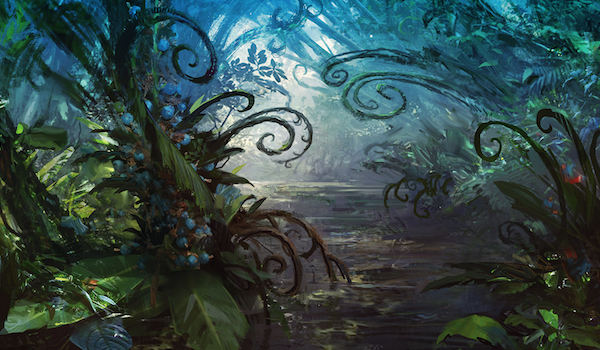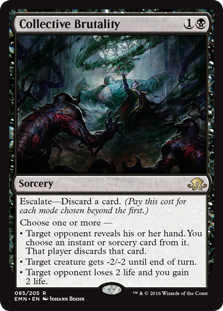Are you a Quiet Speculation member?
If not, now is a perfect time to join up! Our powerful tools, breaking-news analysis, and exclusive Discord channel will make sure you stay up to date and ahead of the curve.
There's a lot to love about Modern, including its incredible deck diversity, large card pool, and plethora of powerful interactions. An often-understated quality of the format is its dynamism. Modern metagames shift subtly at a much faster rate than sites like Modern Nexus can document—a rise in Infect leads to a rise in Jund, which leads to a rise in Tron, etc. Metagame changes form the most obvious aspect of Modern dynamism, but another lies within the decks themselves. As new strategies crop up and the format aligns itself in different ways, household-name decks make adjustments to beat the expected field.

By now, we know Dredge is here to stay in Modern. Like Bant Eldrazi, the deck showed up, enjoyed tremendous success, and then returned to reasonable representation levels as Modern adjusted to beat it. But the shifts to decks inspired by Dredge's induction into Modern have reshaped the format more dramatically than anything we've seen since the Eye of Ugin ban. We've tread these waters before, but have more changes to report as of last week's Star City Games Players' Championship. Split-format events like this rarely reflect the format perfectly but nonetheless serve as an optimal showcase for new technology. This article identifies and examines these shifts in detail.
[wp_ad_camp_1]
Updates to Major Decks
The aforementioned Infect, Jund, and Tron represent Modern's most obvious rock-paper-scissors dynamic. We've explored Jund's transformation in detail—the GBx behemoth has widely adopted Grim Flayer as a fourth efficient two-drop alongside Dark Confidant, Scavenging Ooze, and Tarmogoyf to fill out its threat suite, a move that helps pressure linear decks early while setting up relevant draws and keeping the disruption flowing. As of the Players' Championship, the format's other two pillars join Jund in receiving significant updates.
Fairer Avenues in Infect
Infect, by Max McVety (15th, SCG Players' Championship
It's never been uncommon for Infect to board in non-Infect creatures against interactive decks. Kitchen Finks has always served as the deck's go-to, making Liliana of the Veil awkward, blocking Tarmogoyf twice, and pulling weight against Burn, one of Infect's worst matchups. In that matchup, Infect would lose not because it lost too much life, but because all of its threats would die. The Finks's life-gain, then, often proved less relevant than its (two) bodies.
 Max McVety, in a bid for greatest Infect deck-builder of all time, ran a set of Tarmogoyf in his sideboard for the Players' Championship. Goyf is harder for midrange decks to remove than Kitchen Finks, and can easily spell doom for Lava Spike players. It's quite rare for Burn to beat a pair of on-curve Goyfs.
Max McVety, in a bid for greatest Infect deck-builder of all time, ran a set of Tarmogoyf in his sideboard for the Players' Championship. Goyf is harder for midrange decks to remove than Kitchen Finks, and can easily spell doom for Lava Spike players. It's quite rare for Burn to beat a pair of on-curve Goyfs.
Goyf also comes correct on offense. It can swing for lethal fairly quickly, especially with a pump spell or two in tow. Distortion Strike gains additional value with Goyfs in the deck, since it represents ten damage against decks that struggle to remove a 4/5.
Other than the Goyfs, which I hope we'll see a lot more of in future Infect decks, McVety's list looks pretty stock. Ravenous Trap has caught on as the smoothest "no" button for Dredge (barring Rest in Peace in white), mangling Dredge's hands long-game at the expense of not performing in any other matchup. McVety also really didn't want to lose to Spellskite this tournament, packing three Twisted Image in his 75. You have to wonder if he pushed through an extra point of relevant damage by opening the Tarmogoyf plus Twisted Image combo post-board.
Dark Twists in Tron
BG Tron, by Joe Lossett (1st, SCG Players' Championship
The black splash is a take on Tron we've never seen in Modern, but if any player has the credentials to convince us to take it seriously, it's Joe Lossett. Earlier this year, Lossett made waves (and Top 8) at GP Los Angeles with a set of Bolts in his Tron deck over conventional sweepers. More recently, he helped pioneer Tron's savvy switch from red to white. So I'm pretty inclined to believe that Collective Brutality—the one card in Lossett's deck that actually costs black mana—is as great as it seems.
 Brutality is indeed nuts against Infect and Burn, tougher matchups for Tron. Even though Tron isn't a deck with tons of dead cards to throw away, Brutality gets by in the deck based on what it does: more than it costs.
Brutality is indeed nuts against Infect and Burn, tougher matchups for Tron. Even though Tron isn't a deck with tons of dead cards to throw away, Brutality gets by in the deck based on what it does: more than it costs.
Modern is a format that rewards players for eschewing card advantage in favor of other in-game advantages, including tempo (Disrupting Shoal), mana (Simian Spirit Guide), and card selection (aggressive mulligans). Speedy aggro decks want to have their opponents dead before they get a chance to deploy all the cards in their hands, and Collective Brutality complicates that dreamy scenario.
Without Rest in Peace, Lossett fell back on a full set of Ravenous Trap to punish Dredge. He included these in his deck alongside a pair of mainboard Relic of Progenitus, speaking to Dredge's incredible resilience—the deck's opponents generally need a critical mass of relevant hate to defeat it.
Grixis Delver: A New Hope
Delver as a strategy has historically flourished in varied fields with opponents doing singular, linear things (see: Legacy, Vintage). Until very recently, Modern has not been linear enough for Delver to truly shine.
Grixis Delver isn't exactly a new Modern deck. Our own Ryan Overturf has championed his build of the deck since he joined Modern Nexus some months ago. In the meantime, another group of high-profile Modern players, led by Kevin Jones, have been tweaking a build of the deck heavier on threat diversity.
Grixis Delver, by Kevin Jones (6th, SCG Players' Championship
Ryan vs. Kevin
The Jonesian build of Grixis Delver differs from the Overturf version by including a pair of Young Pyromancer and diversifying the answer suite. Pyromancer has always been quite weak in Modern, but in a format loaded with Rest in Peace and Leyline of the Void, access to early pressure that gets around graveyard hosers seems pretty important. This is part of the reason I went with Counter-Cat over the heavily grave-reliant Temur Delver at the RPTQ last week.
 Mana Leak, Spell Snare, and Terminate are also all scaled back to make room for a pair of Kolaghan's Command and some clunky but powerful one-ofs like Electrolyze and Murderous Cut. These changes seem like a concession to the fact that Grixis Delver is unlikely to always possess the initiative in the early turns, and slightly moves the deck up the archetype spectrum towards midrange.
Mana Leak, Spell Snare, and Terminate are also all scaled back to make room for a pair of Kolaghan's Command and some clunky but powerful one-ofs like Electrolyze and Murderous Cut. These changes seem like a concession to the fact that Grixis Delver is unlikely to always possess the initiative in the early turns, and slightly moves the deck up the archetype spectrum towards midrange.
As Joe Lossett is for Tron, Kevin Jones is something of a spokesperson for Grixis Delver in Modern. I'm sure it's no coincidence that the two other Grixis Delver lists that made Top 16 at the Players' Championship look so strikingly similar to Jones's, featuring the same creature suite and close disruption suites. Hopefully we’ll hear more about the subtleties behind the two different builds from Ryan in coming weeks.
3 Years, 5 Months, and 2 Days...
Modern keeps on keeping on and changing. I've recently read pieces suggesting that Wizards implement new ways to introduce cards to the format, to keep it from getting stale, but Modern has changed so much in the last month alone that I'm not sure these kinds of drastic actions are necessary. One thing's for sure: it's great fun to watch a format in flux, and to adapt to the shifting landscape!





Definitely a good point at the end there. It seems like a lot of people have forgotten that 2016 has seen several completely new decks emerge to viable competitive status between Bant Eldrazi, Dredge and UR Kiln Fiend. And that is just among tier 1 and 2 status decks.
Definitely. I don’t personally believe that Modern will ever “become stale” (meaning newer decks have trouble breaking into the format because Standard’s power level is too weak and the card pool has been exhausted). But I don’t think Wizards would even mind if that DID happen, so long as Modern attendance was high and the format remained so diverse. Modern’s showing no signs of losing on either count, so I wouldn’t be too hopeful for Wizards messing with the format’s stated mission any time soon (including introducing new methods of adding cards to Modern or radically redesigning the ban list).
Totally agree. Frank Lepore’s article was a bad joke from top to bottom.
Speaking of observing the format, are we ever getting metagame updates again? And even if we do, are they going to go back to a regular monthly basis? The lag has been ridiculous because those updates used to be the foundation of this website.
I don’t know much more about this than you do, but I will say that I miss them too, even as someone on the inside. Will pass the word along!
One drastic result is the occurring fall of affinity!
The last two weeks, affinity has been played by as few as 1% of players.
(Probably a result of “sun and moon” entering the meta)
It could be interresting to argue for the unbanning of artisfact lands if this trend continues.
The unravelling of 1 archetype is usually followed by immense chaos…
Lking bth at mtgtop8.cm and tcdecks it turns out that there hasnt been a top 8 affinity deck during all of december, which is telling a lot, since other dectypes havent rested at all during this month.
http://www.tcdecks.net/metagame.php?format=Modern&fecha=2016-12
one odd thing though, the frontpage of tc decks modern decks lists affinity as having 11 decks in top, so that feature must be counting november as well.
Affinity n innin fr an entire mont is pretty drastic news…